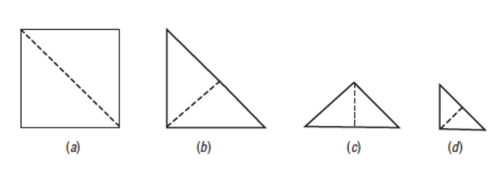Patterns and Inductive Reasoning (1)
Fold a square piece of paper into two as shown in the following figure:

Unfold it and count the number of nonoverlapping triangles formed. Do this four times [see figures (b) to (d) above] and record the results in a table similar to the following:
| Fold |
Number of Nonoverlapping Triangles Formed |
| First | 2 |
| Second | |
| Third | |
| Fourth |
How many triangles do you think will be formed after the fifth fold? Can you fill out the rest of the entries in the table without further folding the sheet of paper? Do you see a pattern?
To answer these questions, use inductive reasoning. Inductive reasoning allows you to make generalizations based on patterns of specific examples or past events.
Definition
